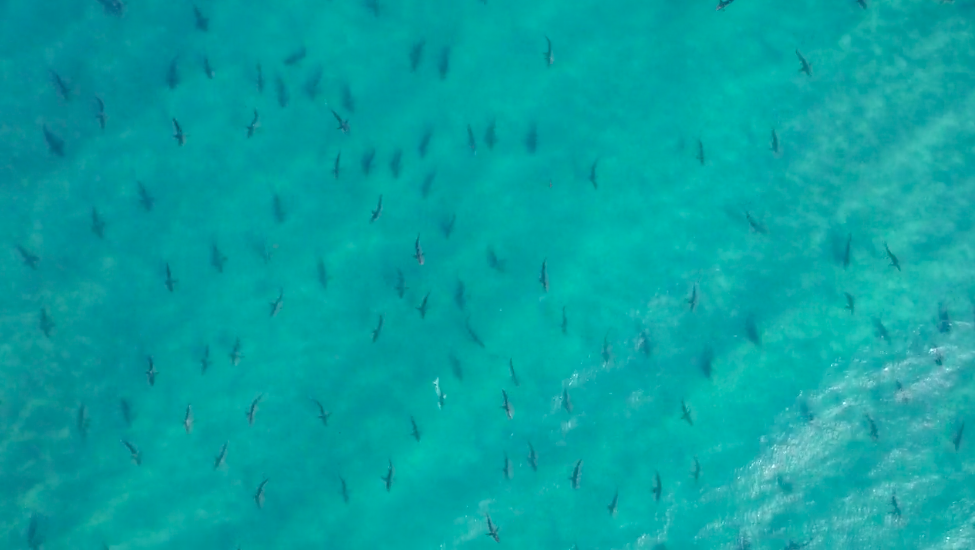Droves of Blacktip Sharks Are Summering in Long Island for the First Time
It turns out that sharks like the Hamptons as much as New Yorkers do.

Sharks making their annual northward migration from Florida have a new summer vacation destination: Long Island.
Blacktip sharks (Carcharhinus limbatus), which range from 4 to 8 feet (1.2 to 2.4 meters) long, spend much of the year in Florida before heading north to cooler waters. In the past, the Carolinas were the sharks' destination of choice. But not anymore. Because of climate change, the waters off North and South Carolina are no longer cool enough in the summer. So blacktips are seeking waters farther north — and Long Island fits the bill. And just like the New Yorkers eager to spend the last weeks of summer in the Hamptons, these finned beachgoers are traveling in droves.
"These blacktips are going way the heck up to Long Island in big numbers — not just a few, but 25, 30 percent of the population," Stephen Kajiura, a shark expert at Florida Atlantic University, told Live Science. "It blows your mind when you see it."
Related: On the Brink: A Gallery of Wild Sharks
Nearly every year since 2011, Kajiura has surveyed the coast of Florida in a plane to see these sharks make their great trek north. There are often so many sharks that, from the sky, it's hard to distinguish the individual sharks. Thousands aggregate in dark clumps. "There are just so many of them," Kajiura said.
Many of these sharks are tagged with devices that allow scientists to track their locations. But it wasn't until 2016 that scientists noticed that many of the tagged sharks' had new migration pattern. At first, it seemed like a fluke, but it’s happened every summer since then — including this one, Kajiura said. Kajiura was blown away by the change.
Sign up for the Live Science daily newsletter now
Get the world’s most fascinating discoveries delivered straight to your inbox.
There are two possible reasons blacktips might choose the Hamptons over the Carolinas, according to Kajiura. It might be that the Carolina waters are getting too hot for them; most sharks, including blacktips, are ectotherms, so they can't cool down their bodies like mammals can. Even a small change in ocean temperature can cause them to overheat. Or, it could be that it's the fish the sharks eat, not the sharks themselves, that are moving due to warming waters — and the sharks are simply following them, Kajiura said. Either way, there's no question about this: Temperatures along the Atlantic Seaboard are changing rapidly. Since 1960, the temperatures of the waters between Cape Hatteras, North Carolina, and the Gulf of Maine have shot up by 3.6 degrees Fahrenheit (2 degrees Celsius), National Geographic reported.
"Whether they're moving themselves, or whether they're moving because their prey are moving, either way, it's a temperature-driven phenomenon," Kajiura said. "The end result is the same."
For now, blacktip sharks may be adapting.There is no evidence that populations of this species are declining overall, according to Kajiura, just that they're edging farther north during the summers. For humans (especially New York humans), the end result might not be as bright.
"You have the potential for more bites on humans than you ever had before," Kajiura said.
Long Island is much more packed with humans than blacktips' former habitat. That means more encounters between sharks and humans are probable, Kajiura said. Although blacktips don't have the same reputation for aggression as their better-known cousins, great whites, these small sharks are responsible for the majority of bites in the US, Kajiura said. That's because blacktips are shallow-water species; they hang out where people swim.
People don't usually die from blacktip bites, Kajiura said. These encounters are typically exploratory "hit-and-runs" where the shark is just as surprised to get a mouthful of human as the human is to feel a shark chomping on their leg. But that doesn't mean people walk away unscathed.
"You're not going to lose a limb, but it's nasty," Kajiura said. "You'll still have a mangled hand or foot."
Most likely, it's not just blacktips that are expanding their range, Kajiura said. It just so happens that scientists have the data for blacktips, and because they hug the coast more than other shark species do, people are more likely to notice them in places where they didn't swim before.
"We can use blacktips as an indicator," Kajiura said. "It's a changing world. It's exciting. But in a way, it's terrifying."
- In Photos: Seeing Sharks Up Close
- Image Gallery: Great White Sharks
- Shark's-Eye-View Video Captures Epic Seal Chase Through Kelp Forest
Originally published on Live Science.

Isobel Whitcomb is a contributing writer for Live Science who covers the environment, animals and health. Her work has appeared in the New York Times, Fatherly, Atlas Obscura, Hakai Magazine and Scholastic's Science World Magazine. Isobel's roots are in science. She studied biology at Scripps College in Claremont, California, while working in two different labs and completing a fellowship at Crater Lake National Park. She completed her master's degree in journalism at NYU's Science, Health, and Environmental Reporting Program. She currently lives in Portland, Oregon.









